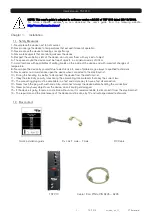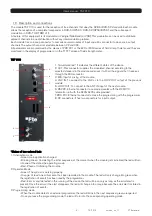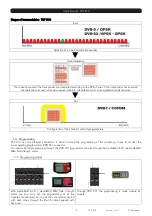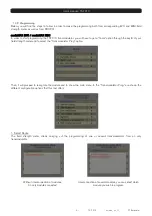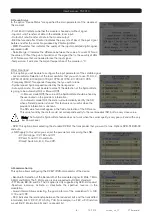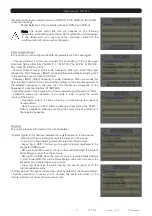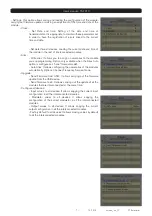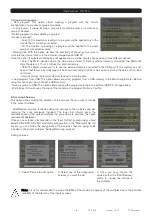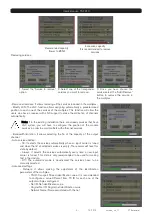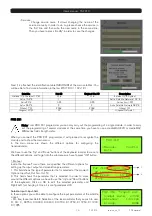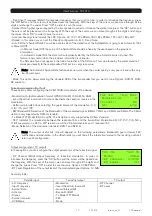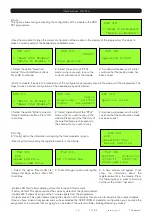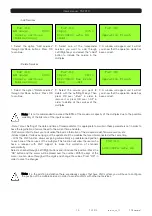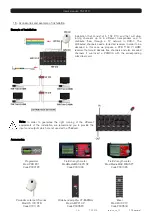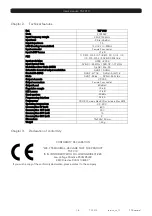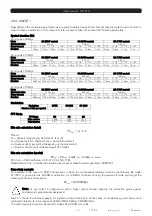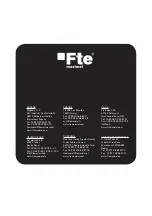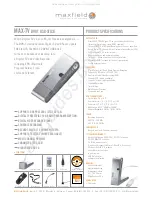
User’s manual · TSF 310
- 5 - TSF 310 version_en_1.1 FTE maximal
2. Device Status
In the option “Device Status” are specified the main parameters of the module at
this moment.
- Front End: It indicates whether the module is hooked or without signal.
- Input bit rate: Transfers of data in the satellite tuner input.
- Output bit rate: Transfer of data in the module output.
- BER before and after Viterbi: It indicates the error rate of bits of the input signal
before and after the correction produced by Viterbi algorithm.
- MER: Parameter that indicates the quality of the input modulated digital signal,
expressed in dB.
- Noise Margin: It indicates the difference between the value of current C/N and
the value of C/N at the point of pixilation of the signal, that is, the quantity of dBs
of C/N measure that are needed to lose the input signal.
-Temperature: It indicates the current temperature of the module in ºC.
3. Set Front End
In this option you will be able to configure the input parameters of the satellite signal:
- Local oscillator: Selection of the local oscillator that you wish to use: FI, KU, C,
K9750, K10000, K10600, K10700, K10750, K11250, K11300, K11325.
- Frequency (MHz): Transponder frequency that you wish to tune.
- Symbol speed: Symbol speed required by the transponder.
- Auto symbol rate: You will be able to select if the detection of the Symbol Rate
is going to be Automatic (On) or Manual (Off).
- In Manual mode (Off), the value of the Symbol Rate should be fixed by
the user based on the provider’s information.
- In Automatic mode (On), the meter will automatically identify the SR
when a Satellite carrier is tuned. This feature is very useful when the
provider’s information is unknown.
The SR value found will appear in the field of selection of the SR menu.
This value found by the meter could not correspond exactly to the real broadcast SR, but to a very close value.
Note: The Automatic Symbol Rate feature does not work when the carrier quality is very poor or/and with a very
low Power Level.
- DVB: This option allows selecting the standard DVB of the transponder that you want to tune. Options:DVB-S1,DVB-S2
and auto.
- LNB Supply: In this option you can set the parameters concerning the LNB:
- RF IN Voltage: 13V, 18V and Off.
- 22 kHz Tone: Off, On and Auto.
- DiseqC Switch: A, B, C, D and Off.
4. Modulator Set Up
This option allows configuring the DVB-T/DVB-H modulator of the device.
- Bandwidth: Selection of the Bandwidth of the modulated signal: 8 MHz, 7 MHz,
6 MHz and 5MHz. The 5 MHz option is only supported by DVB-H standard.
- FFT Mode: 8K, 4K and 2k. The 4k option is only supported by DVB-H standard.
-Spectrum inversion: Activate or deactivate the spectrum reverse in the
modulation.
- Guard interval: Allows selecting the guard interval of the modulation:1/4, 1/8,
1/16 and 1/32.
- FEC: Indicates the relationship between the redundant bits and the transmitted
information bits:1/2, 2/3, 3/4, 5/6 y 7/8. For example, in a FEC = 2/3 relation
we will find 2 information bits and 1 redundant bit.
Summary of Contents for TSF 310
Page 1: ...TSF 310 USER S MANUAL...
Page 2: ......



